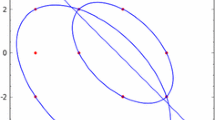Abstract
A more sums than differences (MSTD) set A is a subset of \(\mathbb {Z}\) for which \(|A+A| > |A-A|\). Martin and O’Bryant used probabilistic techniques to prove that a non-vanishing proportion of subsets of \(\{1, \dots , n\}\) are MSTD as \(n \rightarrow \infty \). However, to date only a handful of explicit constructions of MSTD sets are known. We study finite collections of disjoint intervals on the real line, \(\mathbb {I}\), and explore the MSTD question for such sets, as well as the relation between such sets and MSTD subsets of \(\mathbb {Z}\). In particular we show that every finite subset of \(\mathbb {Z}\) can be transformed into an element of \(\mathbb {I}\) with the same additive behavior. Using tools from discrete geometry, we show that there are no MSTD sets in \(\mathbb {I}\) consisting of three or fewer intervals, but there are MSTD sets for four or more intervals. Furthermore, we show how to obtain an infinite parametrized family of MSTD subsets of \(\mathbb {Z}\) from a single such set A; these sets are parametrized by lattice points satisfying simple congruence relations contained in a polyhedral cone associated to A.



Similar content being viewed by others
Notes
As if often the case when dealing with measure theoretic arguments, it does not make a meaningful difference if we use open or closed intervals (or even half-open/half-closed intervals). Certain arguments are cleaner if one uses one or the other, and thus in this paper we shall sometimes assume that the elements of \(\mathbb {I}\) and \(\mathbb {I}_n\) consist of collections of open intervals, and at other times closed intervals.
References
Beck, M., Bogart, T., Pham, T.: Enumeration of Golomb rulers and acyclic orientations of mixed graphs. Electron. J. Comb. 19(3), Paper No. 42 (2012)
Developers, T.S.: SageMath, the Sage Mathematics Software System (Version 7.2) (2016). http://www.sagemath.org
Hegarty, P.V.: Some explicit constructions of sets with more sums than differences. Acta Arith. 130(1), 61–77 (2007). https://doi.org/10.4064/aa130-1-4
Hegarty, P.V., Miller, S.J.: When almost all sets are difference dominated. Random Struct. Algorithms 35(1), 118–136 (2009)
Marica, J.: On a conjecture of Conway. Can. Math. Bull. 12, 233–234 (1969). https://doi.org/10.4153/CMB-1969-029-4
Martin, G., O’Bryant, K.: Many sets have more sums than differences. In: Granville, A., Nathanson, M.B., Solymosi, J. (eds.) Additive Combinatorics. CRM Proceedings and Lecture Notes, vol. 43, pp. 287–305. American Mathematical Society, Providence (2007)
Miller, S.J., Orosz, B., Scheinerman, D.: Explicit constructions of infinite families of MSTD sets. J. Number Theory 130(5), 1221–1233 (2010). https://doi.org/10.1016/j.jnt.2009.09.003
Miller, S.J., Peterson, C., Sprunger, C., Van Peski, R.: The bidirectional ballot polytope. Integers 18, Paper No. A81 (2018)
Nathanson, M.B.: Problems in additive number theory. I. In: Granville, A., Nathanson, M.B., Solymosi, J. (eds.) Additive Combinatorics. CRM Proceedings and Lecture Notes, vol. 43, pp. 263–270. American Mathematical Society, Providence (2007)
Nathanson, M.B.: Sets with more sums than differences. Integers 7, Paper No. A5 (2007)
Pigarev, V.P., Freĭman, G.A.: The relation between the invariants \(R\) and \(T\). In: Freĭman, G.A., Rubinov, A.M., Novoselov, E.V. (eds.) Number-Theoretic Studies in the Markov Spectrum and in the Structural Theory of Set Addition, pp. 172–174. Kalinin. Gos. Univ., Moscow (1973). (in Russian)
Roesler, F.: A mean value density theorem of additive number theory. Acta Arith. 96(2), 121–138 (2000). https://doi.org/10.4064/aa96-2-2
Ruzsa, I.Z.: On the cardinality of \(A+A\) and \(A-A\). In: Combinatorics, Vol. II. Colloquia Mathematica Societatis János Bolyai, vol. 18, pp. 933–938. North-Holland, Amsterdam (1978)
Ruzsa, I.Z.: Sets of sums and differences. In: Bertin, M.-J., Goldstein, C. (eds.) Seminar on Number Theory, vol. 51, pp. 267–273. Birkhäuser, Boston (1984). Progress in Mathematics
Ruzsa, I.Z.: On the number of sums and differences. Acta Math. Hung. 59(3–4), 439–447 (1992). https://doi.org/10.1007/BF00050906
Stanley, R.P.: An introduction to hyperplane arrangements. In: Miller, E., Reiner, V., Sturmfels, B. (eds.) Geometric Combinatorics. IAS/Park City Mathematics Series, vol. 13, pp. 389–496. American Mathematical Society, Providence (2007)
Wolfram Research, Inc.: Mathematica 9.0. https://www.wolfram.com
Zhao, Y.: Constructing MSTD sets using bidirectional ballot sequences. J. Number Theory 130(5), 1212–1220 (2010). https://doi.org/10.1016/j.jnt.2009.11.005
Zhao, Y.: Sets characterized by missing sums and differences. J. Number Theory 131(11), 2107–2134 (2011). https://doi.org/10.1016/j.jnt.2011.05.003
Author information
Authors and Affiliations
Corresponding author
Additional information
Editor in Charge: Kenneth Clarkson
Publisher's Note
Springer Nature remains neutral with regard to jurisdictional claims in published maps and institutional affiliations.
The first named author was partially supported by NSF Grants DMS1265673 and DMS1561945, and the second by DMS1347804. We thank Mel Nathanson, Carsten Sprunger, and Roger Van Peski for helpful conversations, and the referee for a careful reading of the manuscript.
Rights and permissions
About this article
Cite this article
Miller, S.J., Peterson, C. A Geometric Perspective on the MSTD Question. Discrete Comput Geom 62, 832–855 (2019). https://doi.org/10.1007/s00454-019-00109-7
Received:
Revised:
Accepted:
Published:
Issue Date:
DOI: https://doi.org/10.1007/s00454-019-00109-7




